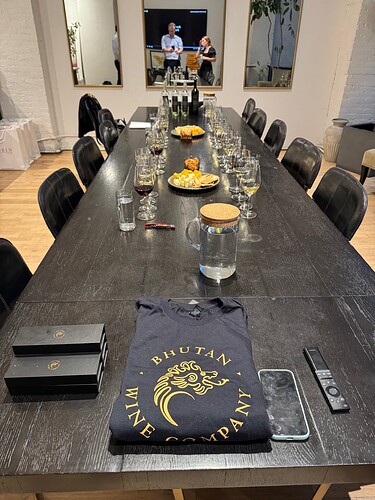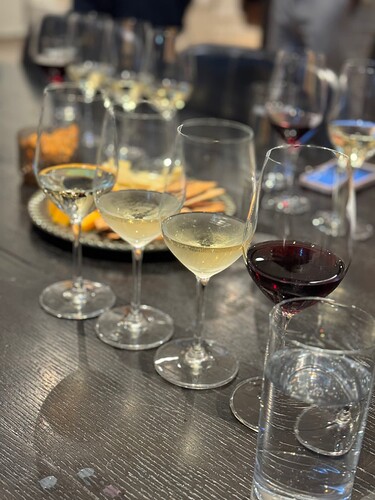I was fortunate to be invited to the very first tasting of Ser Kem wines in the Americas, hosted by the Bhutan Wine Company. Mike Juergens and Ann Cross led the event, joined by several NYC wine professionals, including a Master of Wine. Before the tasting began, we watched a short trailer for the upcoming documentary about the project—which perfectly set the tone. The story behind these wines is remarkable. If you’re not familiar with it, check it out here:
![]() https://www.bhutanwine.com/about-us
https://www.bhutanwine.com/about-us
We tasted four wines, blind. No information was given upfront; instead, we were asked to try each one, describe it, and then guess what it might be. The only clue: all four wines were 100% grown and vinified in Bhutan, and this was their inaugural vintage.
Wine #1
This wine was floral with distinct lychee notes and completely dry. It ended up being the favorite of the flight for most attendees. I was torn between guessing a light Gewürztraminer or a Torrontés. There were a few “no guesses,” one Muscat, and another Torrontés guess—mine included. It turned out to be Traminette, a hybrid grape with Gewürztraminer as a parent. I’ve had a few disappointing Traminettes from the Finger Lakes in the past, so I was pleasantly surprised by the quality here. No one called it correctly—Traminer wasn’t even on anyone’s radar. Solid wine.
Wine #2
This was a dead ringer for Pouilly-Fumé to me—lemon, gunflint, medium-plus acidity. I called Sauvignon Blanc, and only one other person did as well. Turns out: Sauvignon Blanc. Very enjoyable, very good winemaking.
Wine #3
This one threw almost everyone off. French oak dominated the nose, with a slightly tropical note coming through. A couple of guesses leaned Chardonnay, but many people passed on making a guess. I went with oaked Chenin Blanc. It turned out to be Sauvignon Blanc, again—but this time done in a Bordeaux style. So, two Sauvignon Blancs in the flight: one Loire-influenced, one Bordeaux-influenced. I felt the oak hadn’t fully integrated yet; like many good oaked Bordeaux whites, it may need a year or two to come into balance.
Wine #4
A red wine to finish. By this point, a few attendees had finished their glasses and declined to guess. The MW guessed Blaufränkisch, but to me, this was the most obvious wine in the lineup: light color, red cherry notes, medium-plus acidity, medium to medium-minus tannins, clean fruit, and a touch of oak. This felt like a Pinot Noir, stylistically aiming for Burgundy, but with lower alcohol than typical Sonoma Pinots. It was Pinot, and uniquely, it was aged in Bhutanese oak—making it the first fully Bhutanese wine, including yeast, grapes, and oak (the whites had French oak). An enjoyable Pinot with a lot of promise; I could easily see future vintages evolving into something seriously good.
I walked in with low expectations, preparing to be polite. But honestly? The wines were genuinely impressive. I’m excited to follow the Bhutan Wine Company’s journey. Right now, production volumes are tiny and prices for the first vintage are high—driven in part by collectability—but as they hit their stride, I expect pricing to moderate and quality to rise even further. If you ever have the opportunity to taste a flight, you should jump at it.
They recently auctioned off their first vintage at Bonhams, with prices soaring—each bottle paired with unique, collectible experiences:
![]() Bonhams Skinner : Bhutan Wine: The Historical First Vintage
Bonhams Skinner : Bhutan Wine: The Historical First Vintage

